
CHAPTER FOUR Climate Change Mitigation: Technology and Operations 116
Advancing Technology Opportunities To Further Reduce CO2 Emissions
Advancing Technology
Opportunities To Further
Reduce CO
2
Emissions
By International Coordinating Council of Aerospace Industries Associations (ICCAIA)
INTRODUCTION
Improvements in aerodynamic, propulsion and structures
technologies have a direct link to aircraft emissions
reduction. Improvements in systems design and
manufacturing technology are also key to achieving future
aircraft CO
2
-reduction goals.
In the past 5 years, additional advanced long-range twin-
aisle airplanes with significant improvements in each
of these technology areas have entered operational
service (the Boeing 787-9 and -10, the Airbus A350-900
and -1000), while the new Boeing B777-9 aircraft with
a completely new composite wing is being prepared for
certification testing. Moreover, several recently introduced
new single-aisle aircraft (such as the Airbus A220-100 and
-300) and several derivative aircraft with major propulsion
and airframe technology upgrades (such as the Airbus
A320neo and A330neo, the Boeing B737MAX family, and
the Embraer E-Jets E2), have entered operational airline
service and provide substantial reductions in fuel burn.
Large-scale national and international research programs
with cooperation between industry, government and
academia continue to be key enablers to advance and
mature the state of art in breakthrough technologies that
can lead to further reduction in aviation’s environmental
footprint.
Flight demonstrators offer important technical and
integration data to progress technologies such as laminar
flow, advanced structural designs as well as more electric
systems and propulsion.
Integration and certification challenges associated with
advanced technologies are significant and aect the
time frame needed to mature and adopt viable new
technologies into production (on the order of 10-20
years). Maturation and adoption of key technologies
summarized in this Chapter would provide significant
additional opportunities to reduce aeronautical emissions.
AERODYNAMICS
Skin-friction drag and lift-dependent drag are the
largest contributors to aerodynamic efficiency of
commercial aircraft. Advances in materials, structures
and aerodynamics are enabling significantly reduced
lift-dependent drag by increasing eective wing span.
Wing-tip devices typically increase the eective span,
and to further increase wing span in flight some airplanes
may include a folding wing-tip mechanism (Figure 1) for
use on the ground to mitigate span constraints of existing
airport infrastructure.
FIGURE 1: On-ground folding wing tip to maximize in-flight
wing span (Boeing B777-9) (Image courtesy Boeing)
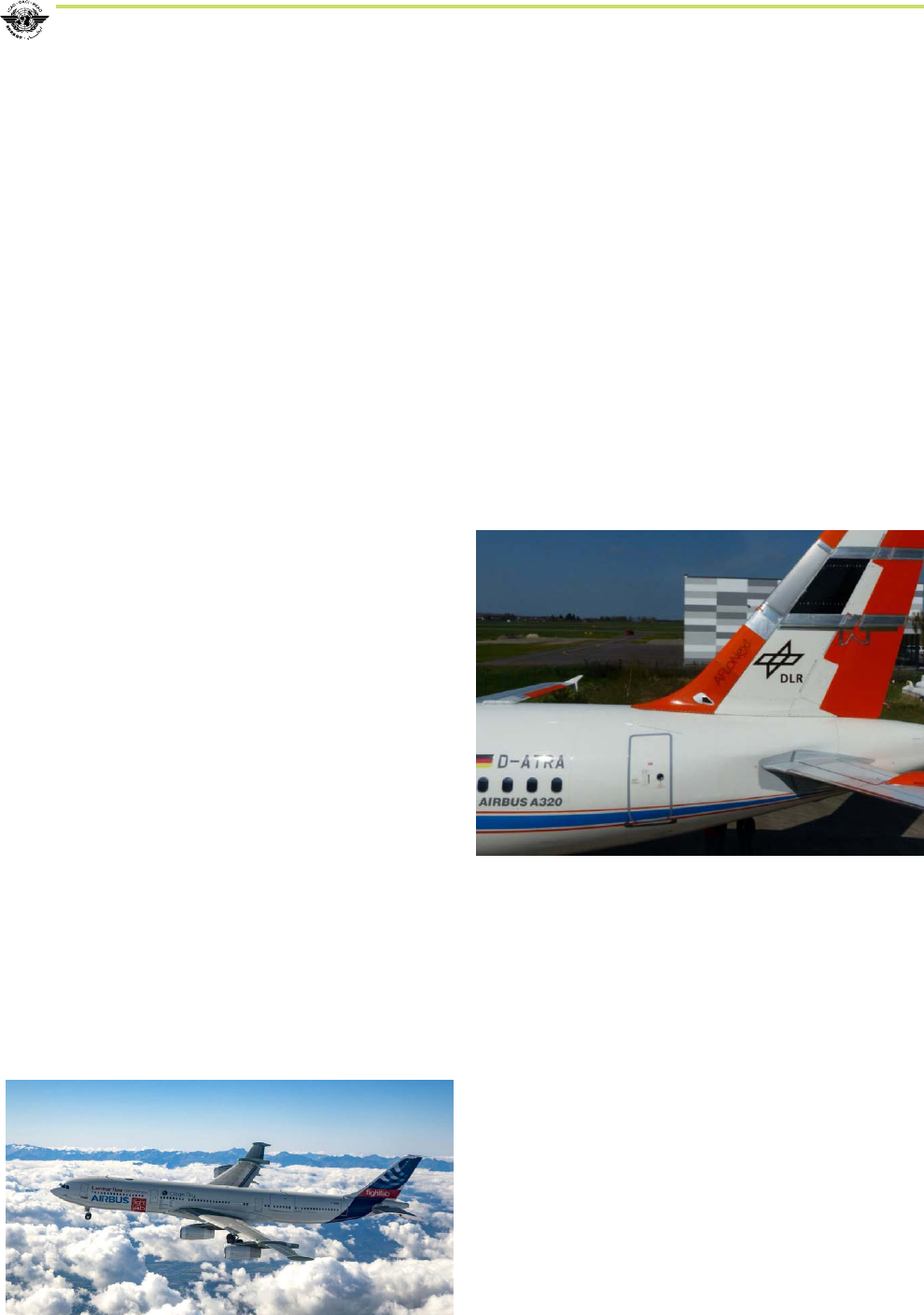
CHAPTER FOUR Climate Change Mitigation: Technology and Operations 117
Advancing Technology Opportunities To Further Reduce CO2 Emissions
Progress is being made in development and testing of
practical aerodynamic and manufacturing technologies
enabling reduced skin friction through laminar and/or
conditioned turbulent boundary-layer flow on portions
of wings, nacelles, tails, and fuselages.
Methods to apply robust micro-scale ‘riblet’ geometries
for turbulent-flow skin-friction reduction continue to
be developed and tested to progress maturation to
practicality. Estimates suggest opportunities on order of
1 - 2% fuel-burn reduction on new and existing aircraft
with significant areas covered by practical ‘riblets’
(Ref. 1). More significant reduction in skin-friction drag
is possible by maintaining laminar flow on forward areas
of engine nacelles, wings and tails. Surfaces intended for
Natural Laminar Flow (NLF) are already present on some
in-production commercial and business-jet aircraft (e.g.,
nacelle-inlet lip and winglets on some larger aircraft, and
portions of wing and fuselage on some business jets).
Achieving laminar flow on aircraft requires well-balanced
aerodynamics and structural designs together with aligned
manufacturing methods to meet necessary surface quality.
Research and developmental flight testing of integrated
wing structures that oer substantial laminar flow as well
as allow high-rate production are critical for technology
maturation. Within the European Clean-Sky 2 Program
(Ref. 2), the BLADE (Breakthrough Laminar Aircraft
Demonstrator in Europe) project has delivered important
data on such wing NLF design concepts. Flight tests
conducted on an Airbus A340-300 (with modified outer
wings that are built to enable NLF) explored limits of
robust laminar flow at various flight conditions (Figure 2).
FIGURE 2: Integrated wing NLF (Natural Laminar Flow)
integration concepts installed on modified outboard wings of
A340-300 (Clean-Sky 2 flight demonstrator BLADE) (Ref. 3)
On wings of very large aircraft and on geometries with
significant sweep such as a vertical fin, laminar flow can
only be realized using suitable surface suction (Hybrid
Laminar Flow Control, HLFC). Recent flight testing of a
vertical-fin HLFC configuration on a single-aisle aircraft
under the European AFloNext (Active Flow, Loads & Noise
control on Next generation wing) program (Figure 3)
complements first HLFC application on the Boeing B787
tail. Overall, practical and robust achievement of
significant laminar flow on wings and other surfaces could
reduce aircraft fuel burn on order of 5%. The magnitude
of potential benefit depends on the fraction of airplane
surfaces manufactured to achieve laminar flow.
FIGURE 3: AFLoNext HLFC empennage flight test on DLR’s
A320 test aircraft (Image courtesy DLR)
Lastly, opportunities for Active Flow Control (AFC) using
localized blowing to keep flow attached over deflected
flaps or over the nacelle-pylon/wing junction have also
been investigated. Such AFC systems if demonstrated
practical may facilitate integration of larger turbofan
engines on wings of future aircraft.
PROPULSION
Three technology paths can reduce propulsion-system fuel
consumption: increase thermal eciency by increasing
the compressor Overall Pressure Ratio (with consequent
increase in core engine operating temperatures); increase
propulsive eciency by increasing the engine Bypass
Ratio (BPR) and consequently fan diameter; and, reduce
installed engine weight and drag.
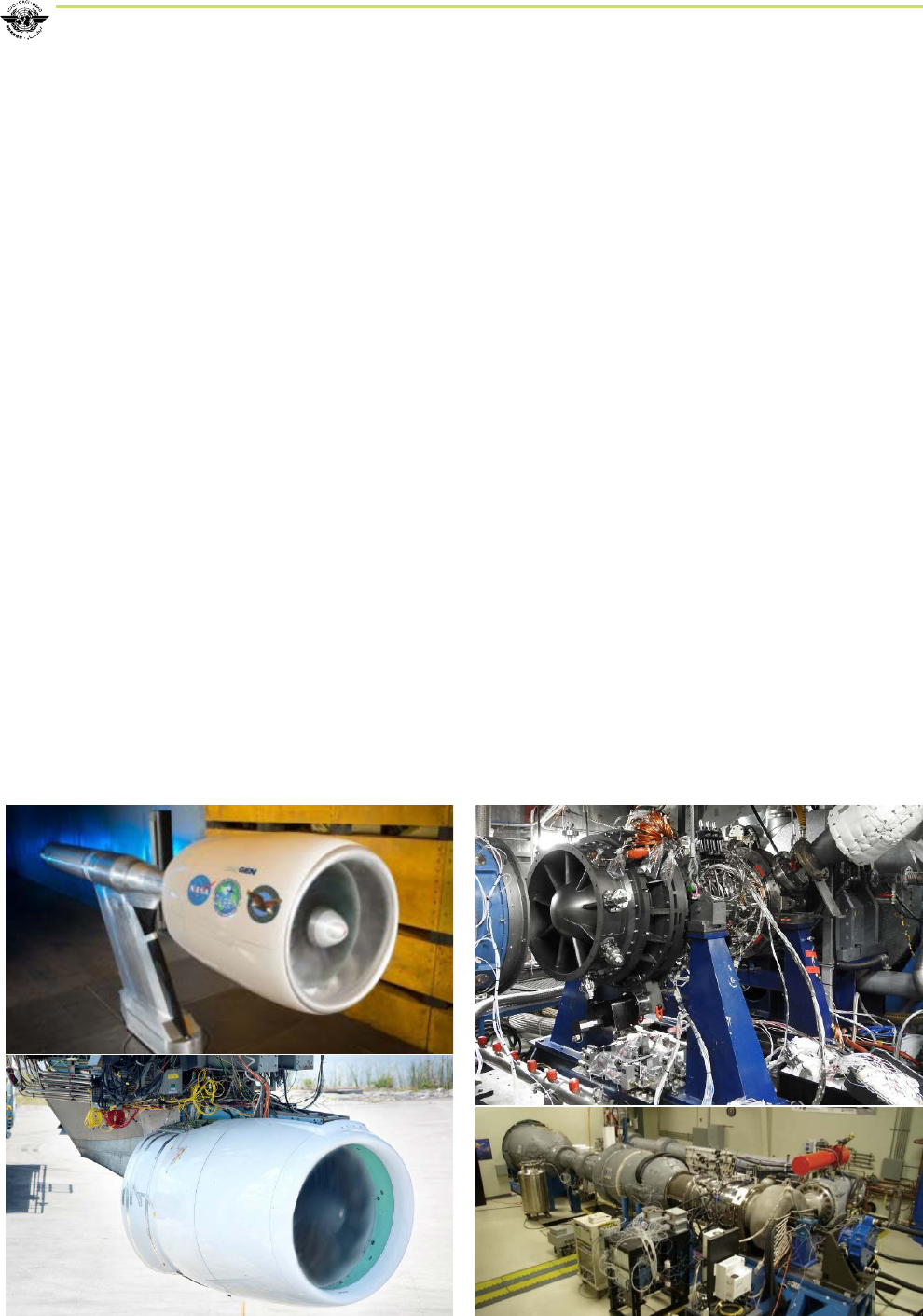
CHAPTER FOUR Climate Change Mitigation: Technology and Operations 118
Advancing Technology Opportunities To Further Reduce CO2 Emissions
Over the last decade, newly introduced aircraft and major
derivatives with new engines have followed these paths
as diameters of engines have increased while aircraft
manufacturers have maintained acceptable installation
and integration penalties. Between 2016 and 2023,
advanced technology engines have entered or will enter
service on new and re-engined aircraft. New technology
engines at BPR’s 9 to 12 for regional jets and single-aisle
aircraft (such as the E2, A220, A320neo, B737MAX, MRJ,
MC-21, and C919) provide a significant 15% reduction
in fuel burn relative to earlier BPR~5 engines. Latest
generation engines for new production twin-aisle aircraft
(A330neo and B777-9) can deliver 10% fuel-burn reduction
relative to 2014 in-service reference.
Major research programs continue to provide important
contributions to develop, mature and demonstrate
promising propulsion technologies along the three
technology paths:
• Within the US, NASA’s ERA (Environmentally
Responsible Aviation) program (Ref. 4)
significantly contributed towards development
and demonstration of advanced propulsion
(Figure 4). The US national research program
CLEEN (Continuous Lower Energy, Emissions,
and Noise) (Ref. 5) is an FAA-led public-private
partnership eort to accelerate development and
deployment of promising certifiable technologies
towards reducing fuel burn by up to 40% compared
to a 2005 baseline. CLEEN Phase-I benefits have
demonstrated potential for 1% fuel-burn reduction
with a Ceramic Matrix Composite engine exhaust
nozzle (demonstrated on a Boeing 787); 5% with
improved impeller/turbine materials and seals; and,
either 20% with Ultra-High Bypass ratio engine
(including Geared Turbofan technology) or 26%
with an Open-Rotor engine configuration. Recent
CLEEN Phase-II contributions are demonstrating
the potential for up to 1% fuel-burn reduction
(each) through compressor and turbine eciency
gains (PW); 3% with electric aircraft systems (GE’s
MESTANG - More Electric Systems and Technologies
for Aircraft in the Next Generation), 1% through
advanced turbine seals (Honeywell), and 1%
FIGURE 4: NASA ERA Wind-Tunnel Test (Top), FAA
CLEEN Phase-I High BPR, Short Inlet Fan Rig and Engine
Demonstrator Program (Bottom)
FIGURE 5: FAA CLEEN Phase-II Compressor (Top) and Turbine
Core Technology Rigs (Bottom)
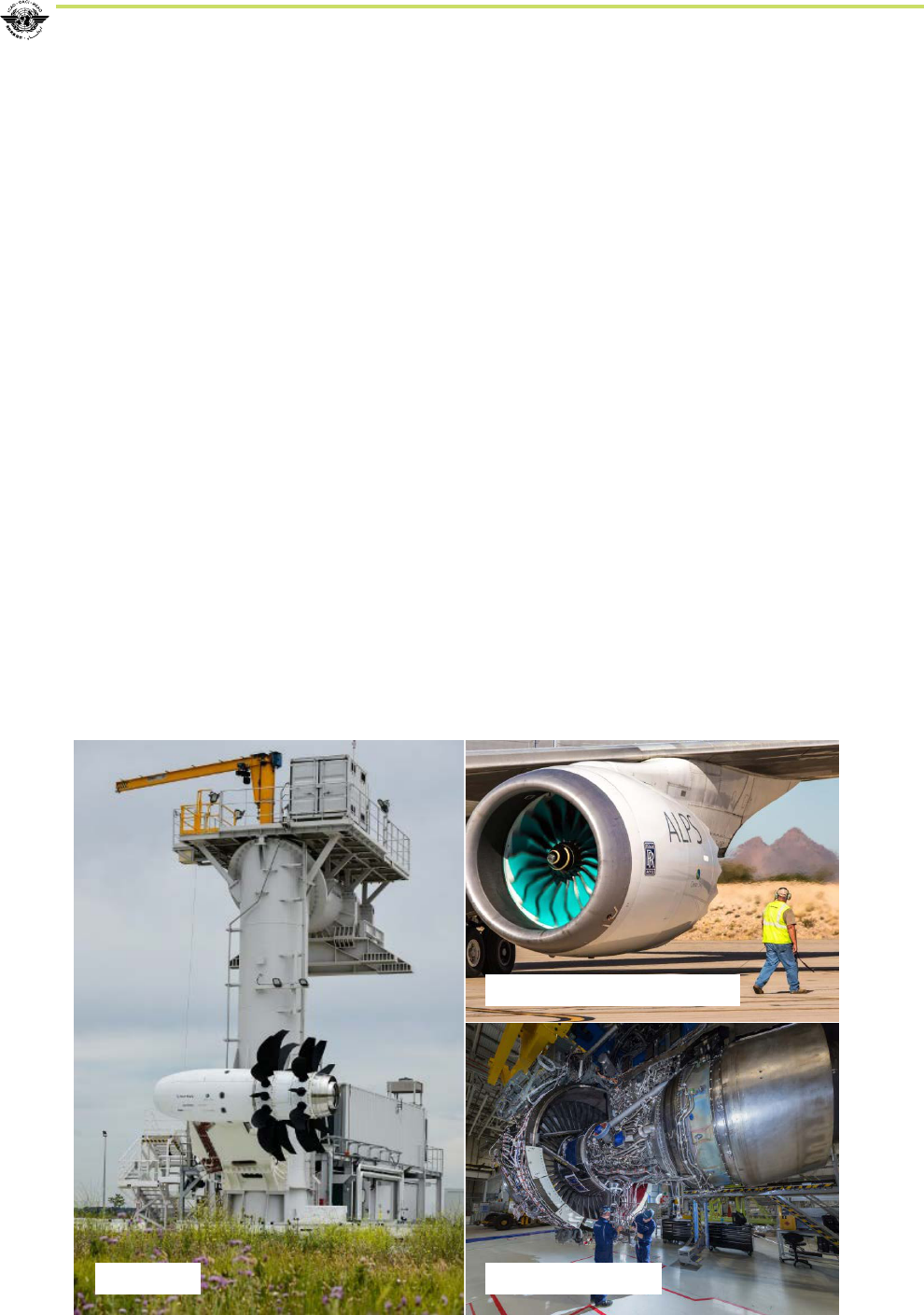
CHAPTER FOUR Climate Change Mitigation: Technology and Operations 119
Advancing Technology Opportunities To Further Reduce CO2 Emissions
through new technology combustor impact on
turbine temperature capability (RR) – see Figure 5.
• Europe’s Clean-Sky 2 Joint Technology Initiative
aims to develop and demonstrate breakthrough
technologies for civil aircraft that could reduce CO
2
emissions by 20% (2025) to 30% (2035) at aircraft
level compared to current state-of-the-art aircraft
(Ref. 4). In the propulsion arena, research builds on
the success of previous Clean-Sky 1 Sustainable and
Green Engines (SAGE) program to validate more
radical engine architectures, including:
– Exploitation of Contra Rotative Open Rotor
(CROR) demonstrator results from the successful
Safran campaign in 2017 (Figure 6);
– Design, development and ground test of a
propulsion system demonstrator to validate
selected low pressure modules and nacelle
technologies for short/medium-range aircraft;
– A short-range regional turboprop demonstrator
(1800-2000 shp class) and small aero-engine
demonstration projects for fixed-wing piston/
diesel and small turboprop engines;
– Full scale ground-test in 2017 (Figure 6) and
flight-testing planned for 2023 of Advanced
Geared and Very High Bypass Ratio large
turbofan engine configurations for large and
middle-of-market type aircraft.
• European collaborative projects completed in
2017-2018, such as ENOVAL (ENgine mOdule
VALidators - led by MTU Aero Engines), LEMCOTEC
(Low Emissions Core-Engine Technologies - led by
Rolls-Royce Deutschland) and E-BREAK (Engine
Breakthrough Components and Subsystems -
led by Safran Helicopter Engines) established
propulsive eciency improvements, higher thermal
eciency, and technological enablers for higher
Overall Pressure-Ratio engines, respectively.
Beyond these demonstrator examples, research into future
more radical propulsion system architectures, such as
hybrid-electric and distributed-propulsion opportunities,
are being pursued by government, academia, and industry.
FIGURE 6: Ground and Flight Demonstrators in Clean-Sky 2 Program (Ref. 4).
Open Rotor
Advanced Low Pressure Systems
Advanced Core 2017
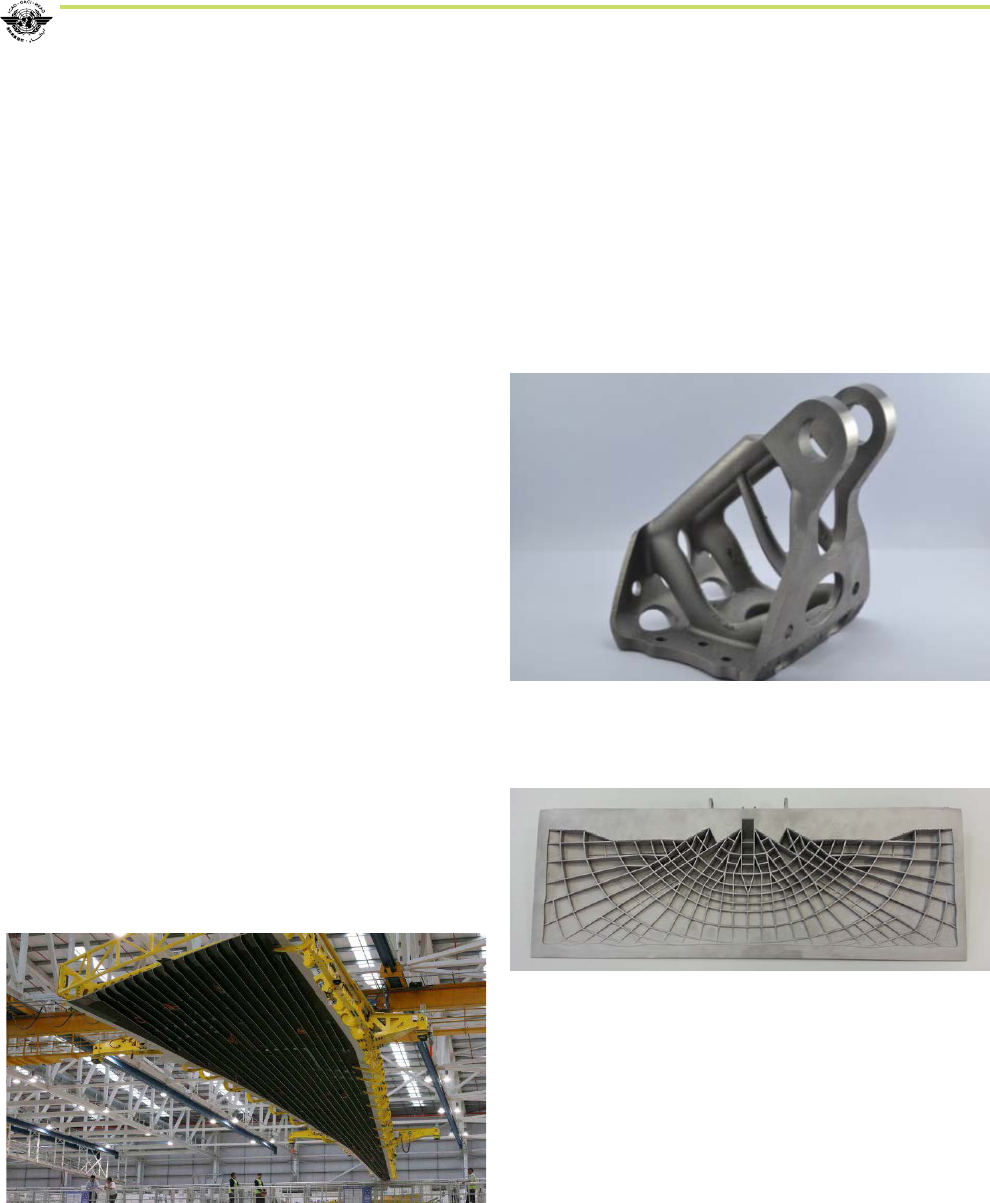
CHAPTER FOUR Climate Change Mitigation: Technology and Operations 120
Advancing Technology Opportunities To Further Reduce CO2 Emissions
STRUCTURAL DESIGN AND
MATERIALS
A key opportunity to reduce fuel burn and CO
2
emissions
is further minimization of aircraft structural weight.
Reduction in empty weight while maintaining structural
requirements (strength, stiness and safety) may be done
with several levers:
• Further optimization of established structural
technologies and/or materials;
• Introduction of new materials and/or structural
technologies; and
• Alternate aircraft architectures.
Composite materials and structures technology have been
developed and introduced in several new small and large
aircraft (Figure 7). There is still progress anticipated in
allowable margins linked to existing materials and in new
designs targeting improved assembly process (such as
bonding, stitching and welding). Aircraft manufacturers
recognize the individual advantages of composites and
advanced metallic alloys - and aim for optimum balance
of both materials. For metallic materials, new alloys have
been developed to be competitive with composites for
thin parts applications (such as fuselages).
FIGURE 7: Composite upper wing skin with composite
stieners for Twin-Aisle aircraft (Ref. 7)
Materials and structural design and optimization is now
more ecient thanks to greatly improved computational
simulation methods. This improved capability can be
coupled with new design and manufacturing technologies
like ALM (Additive Layer Manufacturing) to further
reduce structural weight while optimizing load-carrying
performance (Figs. 8 and 9). Multi-functionality is
another axis of improvement by using the structure
to fulfill additional roles. Structural multi-functionality
can be reached by modifying the material (e.g., via
nanotechnology) or via designs that can provide selected
systems’ functionality and/or geometry adaptivity.
FIGURE 8: Additive manufacturing of optimized part for
reduced component weight (courtesy Airbus)
FIGURE 9: ALM wing spoiler component with “bionic” type
structural optimization (Ref. 8)
Advanced load alleviation is an example of favorable
interaction between aerodynamics and wing structural
design. Further wing-span increase without significant
concomitant weight increase is facilitated by introduction
of reliable load-alleviation systems. The principle is to
provide aerodynamic means to alleviate critical wing loads
via active or passive systems when wing loading exceeds
defined limits (Figure 10). Suitable design of composite
structure can contribute to passive load alleviation via
optimized fiber lay-up (Refs. 9 and 10).
Overall, future weight-reduction opportunities derived
from combination of described technologies is estimated
to be as much as 8% relative to current state-of-the-art
structural configurations.
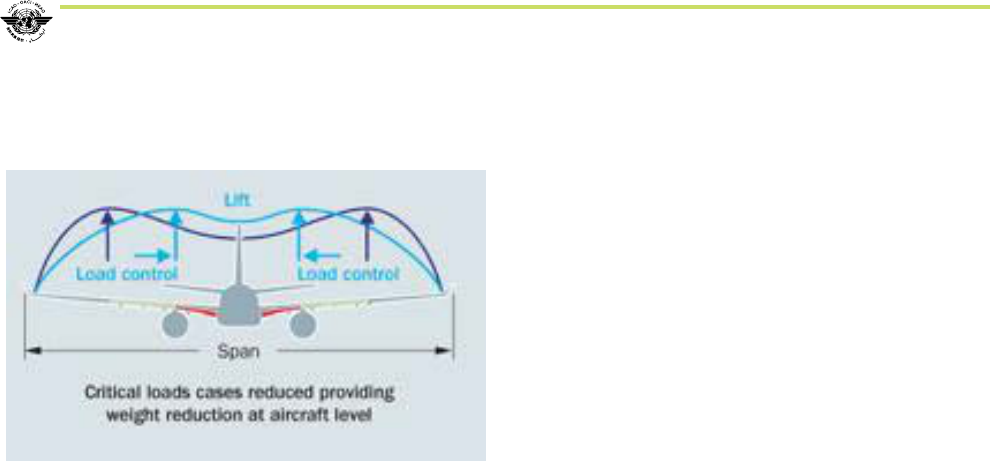
CHAPTER FOUR Climate Change Mitigation: Technology and Operations 121
Advancing Technology Opportunities To Further Reduce CO2 Emissions
FIGURE 10: Wing span-load alleviation system to reduce root
bending moment (schematic)
Finally, alternate aircraft architecture concepts (e.g.,
blended wing or truss-braced wing) may enable further
structural opportunities, allowing larger wing spans and
advanced material technologies for additional fuel-burn
reduction. Maturation of aircraft configurations that
are dramatically different from currently operational
architectures will require significant development and
demonstration to ensure that the same level of safety
and integrated optimization is achieved.
SUMMARY
Several new as well as derivative airplanes with significant
further reduction in fuel-burn are entering the global
aviation system today - and are expected to continue
to do so in the coming years. Airframe and engine
manufacturers are working with governmental, regulatory
and academic research agencies to continue progress
and maturation of promising technologies in the areas
of aerodynamics, propulsion and structural designs that
can be safely, economically, and practically integrated
in existing and new highly optimized aircraft. Further
advances in computational simulation within each
discipline and at the integrated aircraft level can enhance
multi-disciplinary optimization of advanced technologies,
while satisfying manufacturing requirements.
Continued research and development programs are key
to progress technology and aircraft integration concepts
from laboratory and computational research stages to full-
scale demonstration and validation towards operational
and certification readiness. Manufacturing, operational
and economic considerations need to be considered in
technology maturation assessment.
Opportunities in aerodynamic drag reduction, propulsive
technology, manufacturing, structural design, as well
as in aircraft configuration integration are expected
to result in continued reductions in aircraft emissions.
Due to integration complexity, some of the mentioned
technologies may require incorporation in a new airplane
(versus retrofitting existing aircraft), or a new aircraft
configuration architecture altogether.
This article was written in collaboration by the following
ICCAIA members: Jean-Pierre Cabanac, Gerd Heller and
Rudiger Thomas (all Airbus); Krisha Nobrega (Embraer);
Simon Smith (Rolls-Royce); Andrew Murphy (Pratt &
Whitney); Olivier Penanhoat (Safran); Greg Steinmetz
(GE); and Daniel Allyn and Paul Vijgen (all Boeing).
REFERENCES
Document 9963 (2010). Report of the Independent Experts
on the Medium and Long Term Goals for Aviation Fuel Burn
Reduction from Technology, Montreal.
http://www.cleansky.eu/
https://www.airbus.com/newsroom/press-releases/en/2017/09/
airbus_-_blade_-laminar-flow-wing-demonstrator-makes-first-
fligh.html
https://ntrs.nasa.gov/search.jsp?R=20140012638
https://www.faa.gov/about/oce_org/head quarters_oces/
apl/research/aircraft_ technology/cleen/
http://www.cleansky.eu/engines
https://www.newmaterials.com/News_Detail_Jec
_composites_exhibition__carbon_fibre_prepreg_content_on_
each_a350_xwb_is_worth_over_4_million_to_hexcel_12957.asp
http://additivemanufacturing.com/2016/01/27/airbus-group-
pioneering-bionic-3d-printing-learning-from-nature/
https://www.nasa.gov/centers/armstrong/features/pat_wing.
html
https://www.nasa.gov/centers/armstrong/features/highly_
flexible_wings_tested.html
